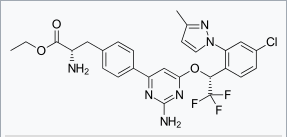Telotristat ethyl
Editor-In-Chief: C. Michael Gibson, M.S., M.D. [1]; Associate Editor(s)-in-Chief: Sonya Gelfand
Disclaimer
WikiDoc MAKES NO GUARANTEE OF VALIDITY. WikiDoc is not a professional health care provider, nor is it a suitable replacement for a licensed healthcare provider. WikiDoc is intended to be an educational tool, not a tool for any form of healthcare delivery. The educational content on WikiDoc drug pages is based upon the FDA package insert, National Library of Medicine content and practice guidelines / consensus statements. WikiDoc does not promote the administration of any medication or device that is not consistent with its labeling. Please read our full disclaimer here.
Overview
Telotristat ethyl is a tryptophan hydroxylase inhibitor that is FDA approved for the treatment of carcinoid syndrome diarrhea in combination with somatostatin analog (SSA) therapy in adults inadequately controlled by SSA therapy. Common adverse reactions include nausea, headache, increased GGT, depression, flatulence, decreased appetite, peripheral edema, and pyrexia.
Adult Indications and Dosage
FDA-Labeled Indications and Dosage (Adult)
- The recommended dosage of telotristat ethyl in adult patients is 250 mg three times daily for patients whose diarrhea is inadequately controlled by SSA therapy.
Dosage Forms and Strengths
- Tablets: 250 mg telotristat ethyl; white to off-white, coated and oval with “T-E” debossed on one side and “250” debossed on the other side.
Off-Label Use and Dosage (Adult)
Guideline-Supported Use
There is limited information regarding telotristat ethyl Off-Label Guideline-Supported Use and Dosage (Adult) in the drug label.
Non–Guideline-Supported Use
There is limited information regarding telotristat ethyl Off-Label Non-Guideline-Supported Use and Dosage (Adult) in the drug label.
Pediatric Indications and Dosage
FDA-Labeled Indications and Dosage (Pediatric)
There is limited information regarding Telotristat ethyl FDA-Labeled Indications and Dosage (Pediatric) in the drug label.
Off-Label Use and Dosage (Pediatric)
Guideline-Supported Use
There is limited information regarding telotristat ethyl Off-Label Guideline-Supported Use and Dosage (Pediatric) in the drug label.
Non–Guideline-Supported Use
There is limited information regarding telotristat ethyl Off-Label Non-Guideline-Supported Use and Dosage (Pediatric) in the drug label.
Contraindications
- None.
Warnings
Constipation
- Telotristat ethyl reduces bowel movement frequency. In a 12-week, placebo-controlled trial, in which patients had 4 or greater bowel movements per day, 2 out of 45 patients treated with a higher than recommended dosage of telotristat ethyl reported constipation. In one patient the constipation was serious, resulting in hospitalization. During the 36-week extension period with higher than the recommended dosage, 10 of 115 patients reported constipation: one developed intestinal perforation and one developed obstruction. In another 12-week, placebo-controlled trial in which patients had less than 4 bowel movements per day, 4 out of 25 patients treated with the recommended dosage of telotristat ethyl reported constipation. Given that patients with metastatic carcinoid tumors may have impaired integrity of the gastrointestinal tract wall, monitor for the development of constipation and/or severe, persistent, or worsening abdominal pain in patients taking telotristat ethyl. Discontinue telotristat ethyl if severe constipation or severe persistent or worsening abdominal pain develops.
Adverse Reactions
Clinical Trials Experience
- Because clinical trials are conducted under widely varying conditions, adverse reaction rates observed in the clinical trials of a drug cannot be directly compared to rates in the clinical trials of another drug and may not reflect the rates observed in practice.
- Telotristat ethyl was studied in a double-blind, placebo-controlled clinical trial of 90 patients with metastatic neuroendocrine tumors and carcinoid syndrome diarrhea. Patients reported between 4 to 12 bowel movements daily despite the use of SSA therapy at a stable dose for at least 3 months. Placebo or telotristat ethyl 250 mg was administered three times daily for 12 weeks. Concomitant anti-diarrheal medications (e.g., loperamide) were used by 43% (36% and 51% in the placebo and telotristat ethyl group, respectively), pancreatic enzyme replacement medications by 39% (36% and 42% in the placebo and telotristat ethyl group, respectively), and opioid analgesics by 29% (24% and 33% in the placebo and telotristat ethyl group, respectively) of patients during the 12-week double-blind period of the trial.
- TABLE 1 below lists adverse reactions occurring at an incidence of at least 5% in the telotristat ethyl group (N=45) and at an incidence greater than placebo (N=45) during the 12-week placebo-controlled period of the trial.
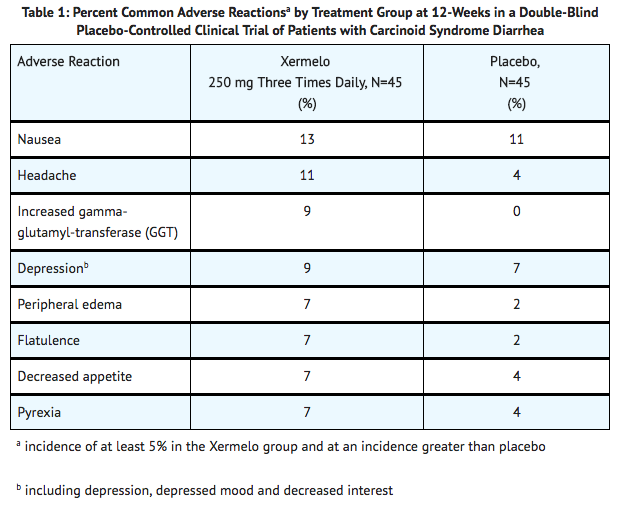
- In another placebo-controlled clinical trial of patients with carcinoid syndrome diarrhea and less than 4 bowel movements per day, the following additional adverse reactions, not listed in TABLE 1, of abdominal pain (including upper and lower abdominal pain, abdominal distention and gastrointestinal pain) and constipation were reported in at least 5% of patients in the telotristat ethyl treated group and at an incidence greater than placebo.
Less Common Adverse Reactions:
- The following is a list of adverse reactions occurring in less than 5% of patients receiving telotristat ethyl during the 12-week placebo-controlled period of the clinical trial:
- Investigations: increased alkaline phosphatase, increased alanine aminotransferase, and increased aspartate aminotransferase.
- Fecaloma was reported in one patient treated with telotristat ethyl during the 36-week open-label extension period following the 12-week double-blind period of the trial.
Postmarketing Experience
There is limited information regarding Telotristat ethyl Postmarketing Experience in the drug label.
Drug Interactions
- CYP3A4 Substrates
- Short-Acting Octreotide
CYP3A4 Substrates
- Concomitant use of telotristat ethyl may decrease the efficacy of drugs that are CYP3A4 substrates (e.g., midazolam) by decreasing their systemic exposure. Monitor for suboptimal efficacy and consider increasing the dose for concomitant CYP3A4 substrates, if necessary.
Short-Acting Octreotide
- Concurrent administration of short-acting octreotide with telotristat ethyl significantly decreased the systemic exposure of telotristat ethyl and telotristat, the active metabolite. If treatment with short-acting octreotide is needed in combination with telotristat ethyl, administer short-acting octreotide at least 30 minutes after administration of telotristat ethyl.
Use in Specific Populations
Pregnancy
Risk Summary
- There are no human data with telotristat ethyl use in pregnant women to inform a drug-associated risk. In animal reproduction studies, no effects on embryo-fetal development were observed with the administration of oral telotristat ethyl to rats during organogenesis at doses up to 750 mg/kg/day (approximately 9 times the exposure at the RHD [recommended human dose]). Treatment of pregnant rabbits with oral telotristat ethyl during organogenesis produced maternal toxicity and post-implantation loss at doses of 250 mg/kg/day or higher (approximately 15 times the exposure at the RHD), and reduced fetal weight at 500 mg/kg/day (approximately 33 times the exposure at the RHD). In a pre-/postnatal development study, an increased incidence of mortality in rat offspring was observed during postnatal days 0 to 4 at the maternal oral dose of 500 mg/kg/day (approximately 5 times the exposure at the RHD), given during organogenesis through lactation.
- The estimated background risk of major birth defects and miscarriage for the indicated population is unknown. All pregnancies have a background risk of birth defect, loss or other adverse outcomes. In the U.S. general population, the estimated background risk of major birth defects and miscarriage in clinically recognized pregnancies is 2% to 4% and 15% to 20%, respectively.
Data (Animal)
- An embryo-fetal development study performed in rats with oral telotristat ethyl at doses up to 750 mg/kg/day (approximately 9 times the AUC [area under the plasma concentration-time curve] for the active metabolite at the RHD) during organogenesis produced no harm to embryo-fetal development.
- In pregnant rabbits treated orally with telotristat ethyl during organogenesis, an increased incidence of post-implantation loss at doses of 250 and 500 mg/kg/day (approximately 15 times the AUC for the active metabolite at RHD) and a decrease in fetal weight at 500 mg/kg/day (approximately 33 times the AUC for the active metabolite at the RHD) was observed. The adverse effects on embryo-fetal development were associated with maternal toxicity (impaired weight gain and/or mortality) at 250 and 500 mg/kg/day. No adverse effects on embryo-fetal development were observed at 125 mg/kg/day (approximately 5 times the AUC for the active metabolite at the RHD).
- A pre-/postnatal development study was conducted in rats using oral administration of 100, 200, and 500 mg/kg/day telotristat ethyl during organogenesis through lactation. An increased incidence of pup mortality was observed during postnatal days 0 to 4 at the maternal dose of 500 mg/kg/day (approximately 5 times the AUC for the active metabolite at the RHD). No developmental abnormalities or effects on growth, learning and memory, or reproductive performance were observed through maturation of offspring at maternal doses of up to 500 mg/kg/day in surviving offspring.
Pregnancy Category (AUS):
There is no Australian Drug Evaluation Committee (ADEC) guidance on usage of Telotristat ethyl in women who are pregnant.
Labor and Delivery
There is no FDA guidance on use of Telotristat ethyl during labor and delivery.
Nursing Mothers
Risk Summary
- There are no data on the presence of telotristat ethyl in human or animal milk, the effects on the breastfed infant, or the effects on milk production. The effects of local gastrointestinal and systemic exposure to telotristat ethyl on breastfed infants are unknown. The developmental and health benefits of breastfeeding should be considered along with the mother's clinical need for telotristat ethyl and any potential adverse effects on the breastfed infant from telotristat ethyl or from the underlying maternal condition.
Clinical Considerations
- Monitor the breastfed infant for symptoms of constipation.
Pediatric Use
- The safety and effectiveness of telotristat ethyl in pediatric patients have not been established.
Geriatic Use
- Of 45 patients in a clinical trial of telotristat ethyl, 19 (42%) patients were 65 years of age and over. No overall differences in safety or effectiveness were observed between these patients and younger patients, and other reported clinical experience has not identified differences in responses between the elderly and younger patients, but greater sensitivity of some older individuals cannot be ruled out.
Gender
There is no FDA guidance on the use of Telotristat ethyl with respect to specific gender populations.
Race
There is no FDA guidance on the use of Telotristat ethyl with respect to specific racial populations.
Renal Impairment
There is no FDA guidance on the use of Telotristat ethyl in patients with renal impairment.
Hepatic Impairment
There is no FDA guidance on the use of Telotristat ethyl in patients with hepatic impairment.
Females of Reproductive Potential and Males
There is no FDA guidance on the use of Telotristat ethyl in women of reproductive potentials and males.
Immunocompromised Patients
There is no FDA guidance one the use of Telotristat ethyl in patients who are immunocompromised.
Administration and Monitoring
Administration
- Take telotristat ethyl with food.
- When short-acting octreotide is used in combination with telotristat ethyl, administer short-acting octreotide at least 30 minutes after administering telotristat ethyl.
- If a dose is missed, take the next dose at the regular time. Do not take 2 doses at the same time to make up for a missed dose.
- Discontinue telotristat ethyl if severe constipation develops.
Monitoring
- Improvement in symptoms of carcinoid syndrome diarrhea may indicate efficacy.
- Constipation.
- Severe persistent or worsening abdominal pain.
IV Compatibility
There is limited information regarding the compatibility of Telotristat ethyl and IV administrations.
Overdosage
There is limited information regarding Telotristat ethyl overdosage. If you suspect drug poisoning or overdose, please contact the National Poison Help hotline (1-800-222-1222) immediately.
Pharmacology
Mechanism of Action
- Telotristat, the active metabolite of telotristat ethyl, is an inhibitor of tryptophan hydroxylase, which mediates the rate limiting step in serotonin biosynthesis. The in vitro inhibitory potency of telotristat towards tryptophan hydroxylase is 29 times higher than that of telotristat ethyl. Serotonin plays a role in mediating secretion, motility, inflammation, and sensation of the gastrointestinal tract, and is over-produced in patients with carcinoid syndrome. Through inhibition of tryptophan hydroxylase, telotristat and telotristat ethyl reduce the production of peripheral serotonin, and the frequency of carcinoid syndrome diarrhea.
Structure
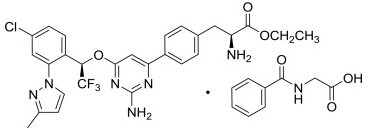
Pharmacodynamics
- In healthy subjects, telotristat ethyl 500 mg three times daily (twice the recommended dosage) for 14 days decreased whole blood serotonin and 24-hour urinary 5-hydroxyindolacetic acid (u5-HIAA) from baseline. A decrease in 24-hour u5-HIAA was observed as early as after 5 days of treatment.
- In patients with metastatic neuroendocrine tumors and carcinoid syndrome diarrhea, 24-hour u5-HIAA decreased from baseline following 6 and 12 weeks of treatment with telotristat ethyl 250 mg three times a day, whereas placebo did not decrease u5-HIAA.
Cardiac Electrophysiology
- At a dose 6 times the recommended dose of 250 mg, telotristat ethyl does not prolong the QT interval to any clinically relevant extent.
Pharmacokinetics
Absorption
- After a single oral dose of telotristat ethyl to healthy subjects, telotristat ethyl was absorbed and metabolized to its active metabolite, telotristat. Peak plasma concentrations of telotristat ethyl were achieved within 0.5 to 2 hours, and those of telotristat within 1 to 3 hours. Plasma concentrations thereafter declined in a biphasic manner. Following administration of a single 500 mg dose of telotristat ethyl (twice the recommended dosage) under fasted conditions in healthy subjects, the mean Cmax and AUC0-inf were 4.4 ng/mL and 6.23 ng•hr/mL, respectively for telotristat ethyl. The mean Cmax and AUC0-inf were 610 ng/mL and 2320 ng•hr/mL, respectively for telotristat. Peak plasma concentrations and AUC of telotristat ethyl and telotristat appeared to be dose proportional following administration of a single dose of telotristat ethyl in the range of 100 mg (0.4 times the lowest recommended dose to 1000 mg [4 times the highest recommended dose]) under fasted conditions.
- Following multiple-dose administration of telotristat ethyl 500 mg three times daily, there was negligible accumulation at steady state for both telotristat ethyl and telotristat.
- In patients with metastatic neuroendocrine tumors and carcinoid syndrome diarrhea treated with SSA therapy, the median Tmax for telotristat ethyl and telotristat was approximately 1 and 2 hours, respectively. Following administration of 500 mg telotristat ethyl three times daily, with meals in patients, the mean Cmax and AUC0-6hr were approximately 7 ng/mL and 22 ng•hr/mL, respectively, for telotristat ethyl. The mean Cmax and AUC0-6hr were approximately 900 ng/mL and 3000 ng•hr/mL, respectively for telotristat. The pharmacokinetic parameters for both telotristat ethyl and telotristat were highly variable with about 55% coefficient of variation.
Food Effect
- Administration of a single 500 mg dose of telotristat ethyl (twice the recommended dose) with food resulted in higher exposure to both telotristat ethyl and telotristat. The systemic exposure to telotristat ethyl, was significantly increased following administration with a high-fat meal, with Cmax, and AUC0-inf being 112%, and 264% higher, respectively compared to the fasted state. Following administration of a single 500 mg dose of telotristat ethyl under the fed conditions in healthy subjects, the mean Cmax and AUC0-inf were 10.5 ng/mL and 21.6 ng•hr/mL, respectively for telotristat ethyl. The Cmax and AUC0-inf values for telotristat were also increased by 47% and 33%, respectively, with a high-fat meal compared to the fasted state. The mean Cmax and AUC0-inf were 908 ng/mL and 2980 ng•hr/mL, respectively for telotristat under the fed condition.
Distribution
- Both telotristat ethyl and telotristat are greater than 99% bound to human plasma proteins.
- In vitro data suggests that telotristat is a substrate of P-glycoprotein.
Elimination
- Following a single 500 mg oral dose of telotristat ethyl in healthy subjects, the apparent half-life was approximately 0.6 hours for telotristat ethyl and 5 hours for telotristat. The apparent total clearance at steady state (CL/Fss) following oral dosing with telotristat ethyl 500 mg three times daily for 14 days (twice the recommended dosage) in healthy subjects was 2.7 and 152 L/hr for telotristat ethyl and telotristat, respectively.
Metabolism
- After oral administration, telotristat ethyl undergoes hydrolysis via carboxylesterases to telotristat, its active metabolite. Telotristat is further metabolized. Among the metabolites of telotristat, the systemic exposure to an acid metabolite of oxidative deaminated decarboxylated telotristat was about 35% of that of telotristat. In vitro data suggest that telotristat ethyl and telotristat are not substrates for CYP enzymes.
Excretion
- Following a single 500 mg oral dose of 14C-telotristat ethyl, 93.2% of the dose was recovered over 240 hours: 92.8% was recovered in the feces, with less than 0.4% being recovered in the urine.
Specific Populations
Age and Sex
- Population pharmacokinetic analysis indicated that age (18 to 83 years) and sex do not affect the pharmacokinetics of telotristat.
Renal Impairment
- Population pharmacokinetic analysis indicated that creatinine clearance (20 to 89 mL/min) does not affect the pharmacokinetics of telotristat. Telotristat ethyl was not studied in end-stage renal disease (ESRD) patients who require dialysis.
Hepatic Impairment
- Population pharmacokinetic analysis indicated that mild hepatic impairment (defined as total bilirubin greater than 1 to 1.5 times the upper limit of normal [ULN] or AST greater than the ULN) does not affect the pharmacokinetics of telotristat. The effect of moderate or severe hepatic impairment (defined as total bilirubin greater than 1.5 times the ULN and any value for AST) is unknown.
Drug Interaction Studies
Effect of Telotristat Ethyl on Other Drugs
In vitro studies
- The potential for telotristat ethyl and telotristat to induce CYP enzymes (1A2 and 2B6) or inhibit CYP enzymes (2B6, 2C8, and 2C9) has not been adequately studied in vitro.
- In vitro telotristat ethyl inhibited P-glycoprotein (P-gp) and breast cancer resistance protein (BCRP), but telotristat did not inhibit P-gp and BCRP at the clinically relevant concentrations. However, in vivo drug interaction potential via inhibition of BCRP is low based on in vitro studies and in vivo findings.
- Based on in vitro studies, in vivo drug interaction potential via inhibition of organic cation transporter 1 (OCT1), OCT2, organic anion transporter 1 (OAT1), OAT3, organic anion transporting polypeptide 1B1 (OATP1B1), OATP1B3, or bile salt export pump (BSEP) transporters by telotristat ethyl and telotristat is low at the recommended dosage.
Midazolam (sensitive CYP3A4 substrate)
- Following administration of multiple doses of telotristat ethyl, the systemic exposure to concomitant midazolam was significantly decreased. When 3 mg midazolam was co-administered orally after 5 day treatment with telotristat ethyl 500 mg three times daily (twice the recommended dosage), the mean Cmax, and AUC0-inf for midazolam were decreased by 25%, and 48%, respectively, compared to administration of midazolam alone. The mean Cmax, and AUC0-inf for the active metabolite, 1'-hydroxymidazolam, were also decreased by 34%, and 48%, respectively. The reduction in the systemic exposure to both midazolam and its active metabolite suggests that the glucuronidation of 1'-hydroxymidazolam may have been increased by telotristat ethyl.
Fexofenadine (sensitive P-gp substrate)
- The Cmax and AUC of fexofenadine increased by 16% when a single 180 mg dose of fexofenadine was co-administered orally with the final dose of telotristat ethyl 500 mg administered three times daily (twice the recommended dosage) for 5 days. Clinically meaningful interactions with P-gp substrates are unlikely.
Effect of Other Drugs on Telotristat Ethyl Short-Acting Octreotide
- The mean Cmax and AUC0-last of telotristat ethyl were decreased by 86% and 81%, respectively, following administration of a single 500 mg dose of telotristat ethyl (twice the recommended dose), co-administered with short-acting octreotide 200 mcg injected subcutaneously in healthy subjects. The mean Cmax and AUC0-last of telotristat were decreased by 79% and 68%, respectively.
Nonclinical Toxicology
Carcinogenesis, Mutagenesis, Impairment of Fertility
- In a 26-week study in transgenic (Tg.rasH2) mice, telotristat ethyl was not tumorigenic at oral doses up to 300 mg/kg/day.
- Telotristat ethyl was negative in the in vitro Ames test, the in vitro chromosomal aberration test using Chinese hamster ovary cells, and the in vivo rat micronucleus test.
- Telotristat ethyl at oral doses up to 500 mg/kg/day (approximately 5 times the AUC for the active metabolite at the RHD) was found to have no effect on fertility and reproductive performance of male or female rats.
Clinical Studies
- A 12-week double-blind, placebo-controlled, randomized, multicenter trial of telotristat ethyl was conducted in adult patients with a well-differentiated metastatic neuroendocrine tumor and carcinoid syndrome diarrhea who were having between 4 to 12 daily bowel movements despite the use of SSA therapy at a stable dose for at least 3 months. Patients were randomized to placebo or treatment with telotristat ethyl 250 mg three times daily.
- Study medication was administered within 15 minutes before or within 1 hour after a meal or snack. All patients were required to stay on their baseline SSA regimen and were allowed to use rescue medication (short-acting octreotide) and antidiarrheals (e.g., loperamide) for symptomatic relief. A total of 90 patients were evaluated for efficacy. The mean age of the population was 63 years of age (range 37 to 83 years), 50% were male, and 90% were White.
- The primary efficacy endpoint was the change from baseline in the number of daily bowel movements averaged over the 12-week treatment period. The analysis results can be found in TABLE 2 below. The average was based on the number of days with valid, non-missing data. When a patient had more than 6 weeks of missing data, the change from baseline was considered equal to zero. A week of missing data was defined as a patient missing at least 4 days of diary data in that week.
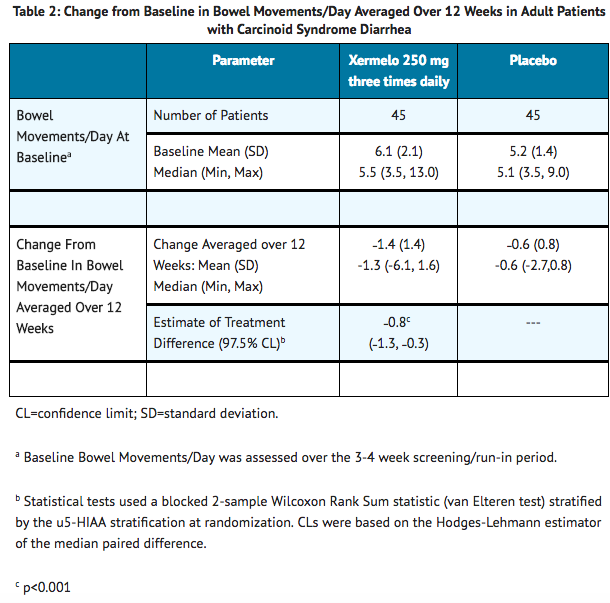
- In the 12-week study, a difference in average weekly reductions in bowel movement frequency between telotristat ethyl and placebo was observed as early as 1 to 3 weeks, and persisted for the remaining 9 weeks of the study.
- To aid in the interpretation of the bowel movement reduction results, the proportion of patients reporting any particular level of reduction in overall average bowel movement frequency is depicted in Figure 1 below. For example, 33% of patients randomized to telotristat ethyl and 4% of patients randomized to placebo experienced a reduction in overall average bowel movements from baseline of at least 2 bowel movements per day.
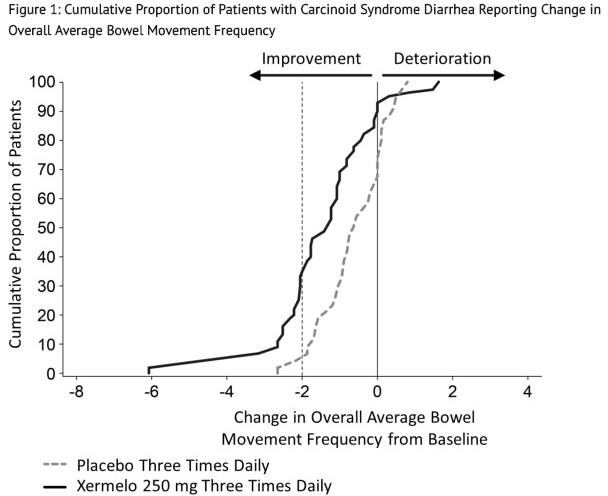
- Other symptoms of carcinoid syndrome (abdominal pain or flushing) did not show improvement in the comparison of telotristat ethyl to placebo.
- The average number of daily short-acting octreotide injections used for rescue therapy over the 12-week double-blind treatment period was 0.3 and 0.7 in the telotristat ethyl and placebo groups, respectively. In the subgroup of patients who received short-acting octreotide injections, observed reductions in the number of bowel movements per day and treatment differences were generally consistent with the reductions and differences observed in patients who did not receive rescue therapy, and were similar to the overall data presented in TABLE 2 above.
- A third randomized treatment arm of telotristat ethyl 500 mg three times daily did not demonstrate additional treatment benefit on the primary endpoint and had a greater incidence of adverse reactions than telotristat ethyl 250 mg three times daily. Therefore, telotristat ethyl 500 mg three times daily is not recommended.
How Supplied
- 250 mg tablet: white to off-white coated oval tablet with “T-E” debossed on one side and “250” debossed on the other side.
- Telotristat ethyl is dispensed in a monthly case for a total of 28 days of therapy. Each monthly case contains four weekly boxes. Each weekly box contains seven daily dose packs (day pack).
- NDC 70183-125-84: Monthly case of 84 tablets. Each child resistant daily dose pack (day pack) contains three 250 mg tablets.
Storage
- Store at 25°C (77°F); excursions permitted to 15°C to 30°C (59°F to 86°F).
Images
Drug Images
{{#ask: Page Name::Telotristat ethyl |?Pill Name |?Drug Name |?Pill Ingred |?Pill Imprint |?Pill Dosage |?Pill Color |?Pill Shape |?Pill Size (mm) |?Pill Scoring |?NDC |?Drug Author |format=template |template=DrugPageImages |mainlabel=- |sort=Pill Name }}
Package and Label Display Panel
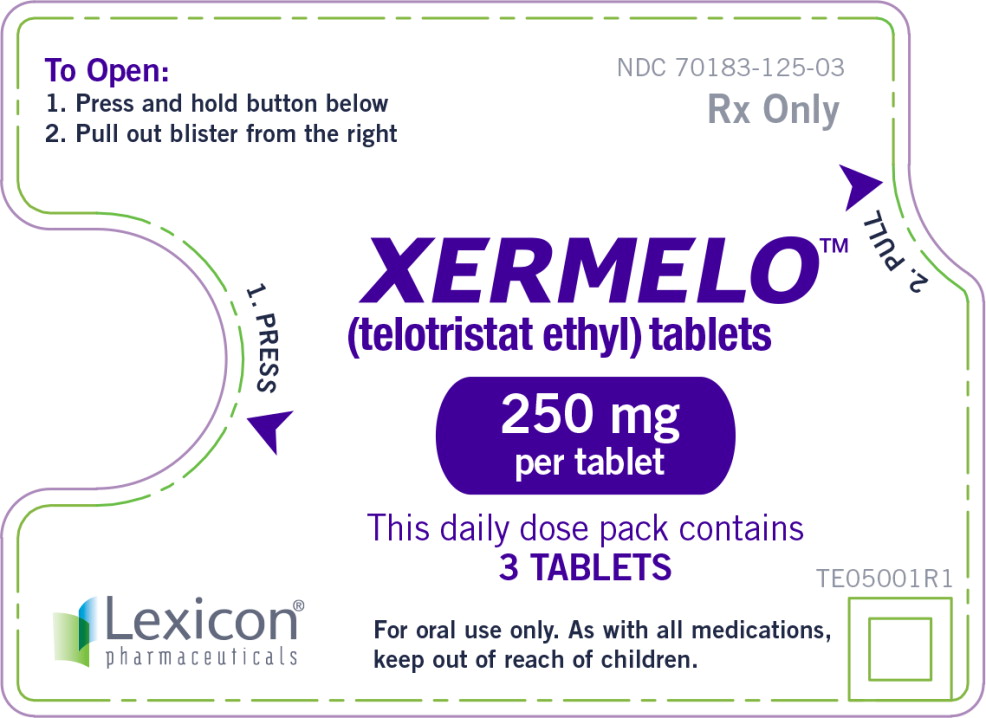
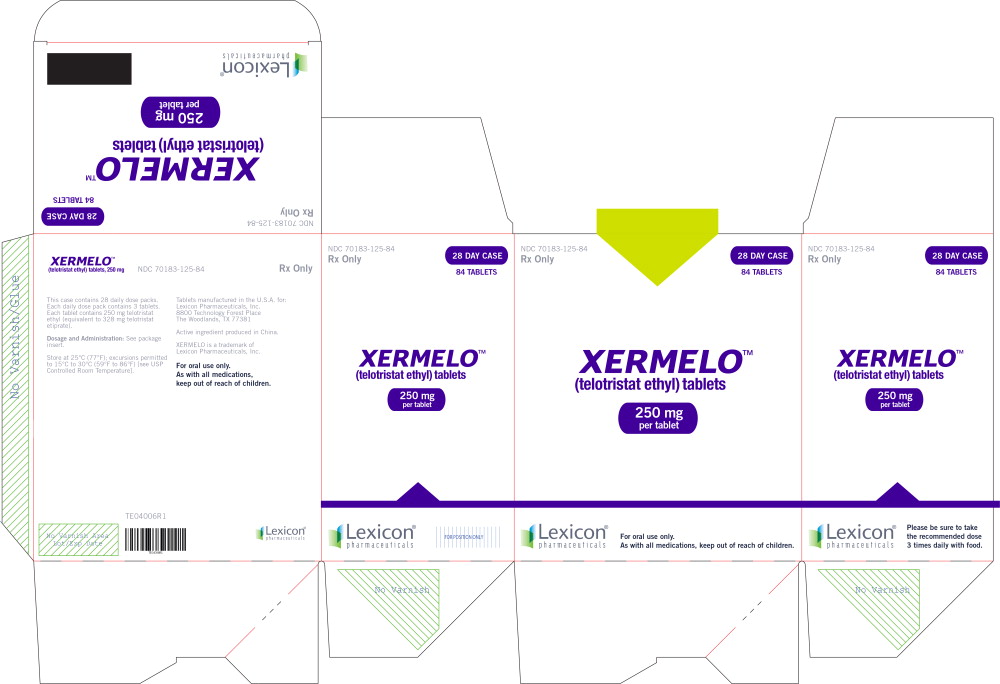
{{#ask: Label Page::Telotristat ethyl |?Label Name |format=template |template=DrugLabelImages |mainlabel=- |sort=Label Page }}
Patient Counseling Information
- Advise patients:
- If they experience severe constipation or severe persistent or worsening abdominal pain, to discontinue telotristat ethyl and contact their healthcare provider.
- To take telotristat ethyl with food.
- When short-acting octreotide is used in combination with telotristat ethyl, administer short-acting octreotide at least 30 minutes after administering telotristat ethyl.
- If a dose is missed, take the next dose at the regular time. Do not take 2 doses at the same time to make up for a missed dose.
Precautions with Alcohol
Alcohol-Telotristat ethyl interaction has not been established. Talk to your doctor regarding the effects of taking alcohol with this medication.
Brand Names
- Xermelo
Look-Alike Drug Names
There is limited information regarding Telotristat ethyl Look-Alike Drug Names in the drug label.
Drug Shortage Status
Drug Shortage
Price
References
The contents of this FDA label are provided by the National Library of Medicine.
- ↑ "Xermelo (telotristat ethyl) Tablets, for Oral Use. Full Prescribing Information" (PDF). Lexicon Pharmaceuticals, Inc. 8800 Technology Forest Place. The Woodlands, TX 77381. Retrieved 1 March 2017.
